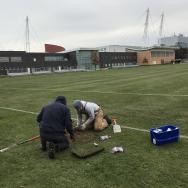The bell tower of Rockefeller Memorial Chapel is normally populated by tourists and the University’s carillonneur. But scientists recently scaled its 271 stone steps to the highest point on campus in order to study air quality and pollution across Chicago.
At Rockefeller, researchers from UChicago and Harvard University ran a long tube down the stone tower to a humming machine, which analyzed air for methane as it blew past the tower. Across campus, another instrument atop the Knapp Center for Biomedical Discovery allowed UChicago scientists to test isotopes in water vapor.
The data will be used to create a map of the air around Chicago’s urban center and what it contains. That will allow scientists to study the region’s air quality, but also deepen their understanding of the interplay between pollution, weather and atmospheric transport.
“The more we study the atmosphere, the more complex we often find the answers to such questions are,” said Assoc. Prof. Elisabeth Moyer, whose lab is running one project and assisting with the other. “This is a nice opportunity to get some data in areas where there are gaps.”
‘Where science and art intersect’
Rockefeller Chapel is one of the most iconic buildings on campus. Because it doesn’t have exhaust vents like newer buildings, its nearly 100-year-old infrastructure makes it a perfect place to take air measurements.
The Chapel was thrilled to assist the scientists. “The building itself is built on Enlightenment principles—a place where science and art intersect,” said Matthew Dean, director of chapel operations. “It was built as a center of light and acoustics, of inquiry and exploration, and that’s always been a motivation for us.”
Last spring, Rockefeller staff helped Harvard graduate student Cody Floerchinger and UChicago postdoctoral researcher Ben Clouser wind an air sampling tube down from the tower to its basement, where a spectrometer analyzes the methane content in the air.












 —Prof. Kunle Odunsi
—Prof. Kunle Odunsi
